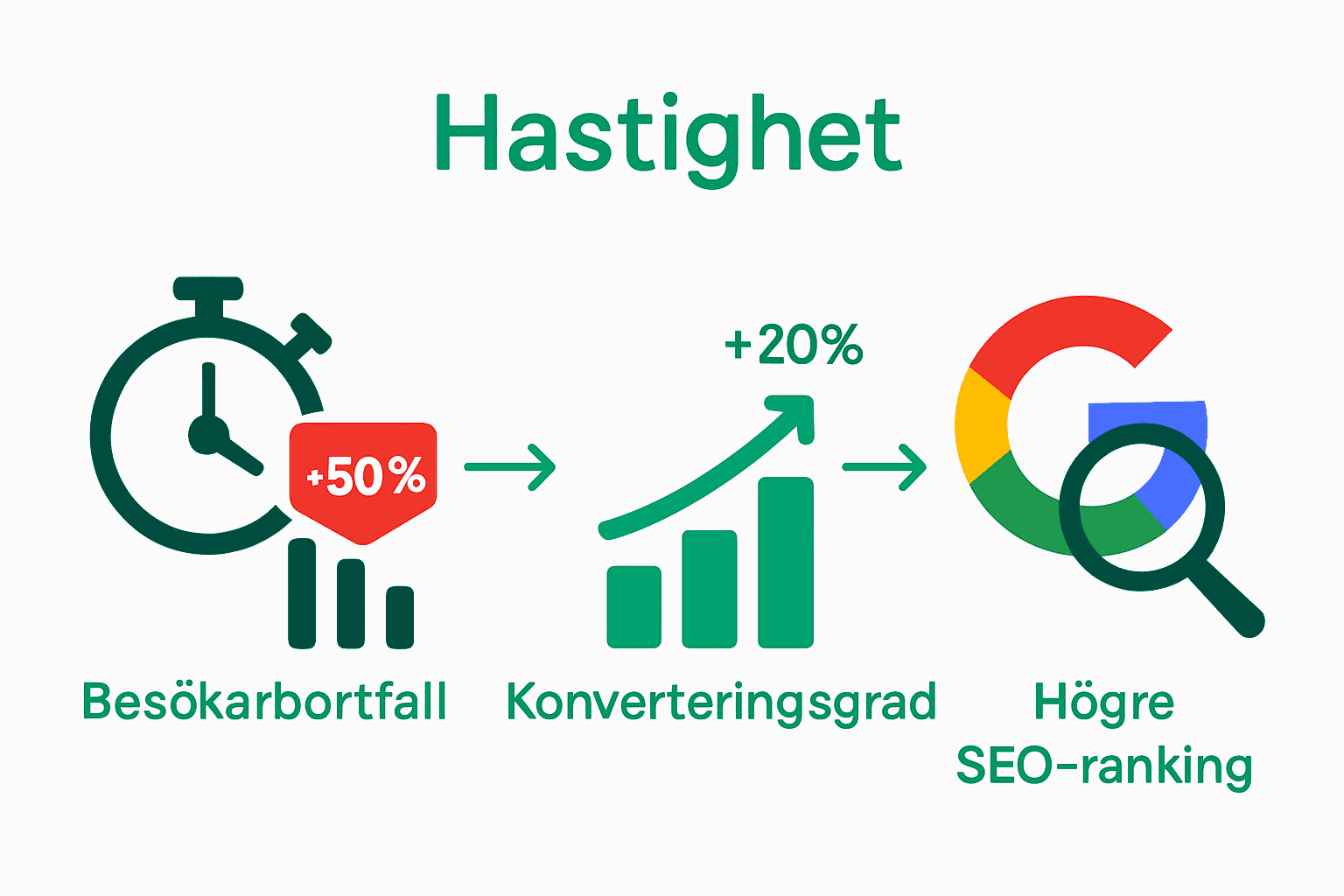Over 53 percent of mobile users abandon a slow website after just three seconds. It can feel hopeless when a page takes too long to load and visitors leave before you’ve even had a chance to grab their attention. With the right speed optimization, both the customer experience and your company’s digital visibility will improve, creating opportunities for better rankings and more business today.
Table of contents
- What is speed optimization and why is it needed?
- How website speed affects SEO and rankings
- User experience and conversion rate with faster pages
- Common causes of slow website and solutions
- Costs, risks and benefits of optimization
Key Points
| Point | Details |
|---|---|
| Speed optimization is crucial | A fast website improves user experience and increases conversion rates, which is crucial for digital competitiveness. |
| SEO is affected by website speed | Faster websites rank higher on search engines, which directly affects visibility and traffic. |
| User experience and conversion are linked | Slow loading times can lead to higher bounce rates and lower conversion rates. |
| Investment in speed optimization | Despite initial costs, optimization provides long-term benefits through improved performance and user satisfaction. |
What is speed optimization and why is it needed?
Speed optimization is about improving your website’s loading time and overall performance through technical adjustments and strategic actions. It’s not just a technical detail – it’s critical to your business’ digital success. A slow website can mean lost customers, lower search rankings, and reduced credibility.
When we talk about speed optimization, we focus on several critical aspects that affect the user experience. These include reducing unnecessary code blocks, compressing images, leveraging browser caches, and minimizing external scripts. By optimize website performance can dramatically improve their digital presence and conversion rates.

Why is speed optimization so important? Modern users have extremely short tolerance thresholds. Research shows that a full 53% of mobile users will abandon a website that takes more than three seconds to load. This translates into direct business loss. A fast website signals professionalism, builds trust, and provides users with a smooth experience that encourages continued engagement.
Main benefits of speed optimization include:
- Improved search engine ranking
- Higher conversion rate
- Reduced bounce rate
- Better user experience
- Stronger brand perception
For small and medium-sized businesses, speed optimization is no longer an option – it is a necessity for digital competitiveness.
How website speed affects SEO and rankings
Website speed is a crucial factor for search engine optimization (SEO) and rankings. Google has clearly communicated that page load time is a direct ranking signal, meaning that faster websites generally rank higher in search results. This is especially critical for mobile searches, where user experience is central.
When Google evaluates a website, the algorithm looks at several speed-related parameters. SEO Trends for 2024 confirms that Core Web Vitals – a set of metrics that measure website performance – are playing an increasingly important role. These include load time, interactivity, and visual stability, which directly affect how search engines perceive and rank your website.
Speed optimization not only affects technical ranking algorithms, but also user behavior. Slow websites lead to higher bounce rates, less time spent on page, and fewer conversions. Google interprets these signals as indicators of low quality, which further degrades your rankings. A fast, responsive website signals professionalism and user-friendliness.
Important SEO aspects related to website speed:

- Improved crawl efficiency for search engine robots
- Lower bounce rate
- Higher average session time
- Better user experience
- Increased likelihood of link sharing and repeat visitors
For small and medium-sized businesses, speed optimization is not just a technical nicety – it is a direct competitive advantage in the digital marketing world.
User experience and conversion rate with faster pages
User experience and website speed are directly linked. Modern users expect instant response and have an extremely low tolerance for slow loading times. Every second of delay can result in a significant decrease in user engagement and potential business opportunities.
According to the conversion optimization guide for 2025 Page load time directly impacts conversion rates. A delay of just a few seconds can reduce conversion rates by up to 20%. This means that every millisecond counts when it comes to retaining potential customers’ interest and converting them into actual purchases or actions.
Speed optimization is not just about technical details, but also about the psychological aspects of user interaction. Fast websites signal professionalism, credibility, and respect for the user's time. Users associate loading speed with a company's overall quality and service level, which has direct consequences for brand perception and ultimately conversion rates.
Key factors that affect user experience and conversion:
- Charging time under 2 seconds
- Instant visual feedback
- Responsive design for different devices
- Intuitive navigation interface
- Minimal disruption during charging
For small and medium-sized businesses, investing in website speed isn't just a technical improvement – it's a strategic business investment that directly impacts the bottom line.
Common causes of slow website and solutions
A slow website can have several underlying technical causes that affect its performance. The most common issues include oversized and uncompressed images, complex code, too many external scripts, and inefficient server infrastructure. Any of these factors can dramatically slow down your website's load time and degrade the user experience.
Fast and secure web hosting emphasizes the importance of the right hosting solution as a fundamental part of website speed optimization. Poorly chosen web hosting servers can result in slow response times, limited bandwidth, and poor technical performance. A professional hosting solution ensures fast data transfer, robust infrastructure, and optimized resources.
Among the most critical measures to improve website speed are image optimization, caching strategies, and HTTP request minimization. Developers need to systematically work on reducing unnecessary code, leveraging modern compression techniques, and implementing intelligent caching mechanisms that reduce server load.
Key elements for speed improvement:
- Optimize and compress images
- Implement browser caching
- Reduce external JavaScript libraries
- Using Content Delivery Networks (CDNs)
- Minimize unnecessary CSS and JavaScript
For small and medium-sized businesses, speed optimization is about continuously evaluating and improving their digital infrastructure – an ongoing process that requires technical insight and strategic thinking.
Costs, risks and benefits of optimization
Speed optimization is an investment that requires careful financial and strategic planning. Small and medium-sized businesses need to understand the potential costs, risks, and long-term benefits of a well-thought-out optimization process. Initial investments can vary depending on the complexity of the website, but the long-term benefits often outweigh the initial outlay.
According to RankTracker Optimization strategies that reduce the number of unnecessary elements, implement asynchronous loading, and enable browser caching can dramatically improve website performance. These technical adjustments may involve initial development costs but result in significant savings through improved user experience and higher conversion rates.
The risks of not optimizing often outweigh the investment costs. Slow websites lead to poor search engine rankings, lower user engagement, and reduced credibility. A poorly optimized website can cost businesses up to 40% in potential conversions, which is a significantly greater financial loss than the costs of a professional optimization process.
Key elements of the cost and profit calculation:
- Initial technical review and optimization
- Continuous performance monitoring
- Regular technical updates
- Investing in the right hosting solutions
- Training of internal staff
For small and medium-sized businesses, speed optimization is about looking beyond the immediate costs and focusing on the long-term strategic benefits.
Take control of your website speed and maximize your digital success
Have you noticed how slow loading times affect both rankings and customer trust? The article “Why Speed Optimization: The Complete Guide for Businesses” highlights key issues like oversized images and inefficient server infrastructure as common obstacles. These are challenges that iMarketing.se specializes in solving for small and medium-sized businesses that want to improve both SEO and conversion rates.

Do you want to quickly improve your website performance and give your visitors a user experience that builds trust and increases sales? We can help you with everything from optimizing your website's performance to choosing fast and secure web hosting that suits your business's needs. Take the plunge today and see how a well-optimized site can transform your digital presence. Visit iMarketing.se and let us guide you to a faster and more profitable website!
Frequently Asked Questions
What is speed optimization?
Speed optimization is about improving a website's loading time and performance through technical adjustments and strategic actions.
How does website speed affect SEO?
Website speed is a ranking signal for Google. A faster website often ranks higher in search results, increasing visibility.
What are the benefits of speed optimization for businesses?
Some of the benefits include improved search engine rankings, higher conversion rates, lower bounce rates, and a better user experience.
What common problems can cause a slow website?
Common causes include oversized images, complex code, too many external scripts, and poor server infrastructure.


